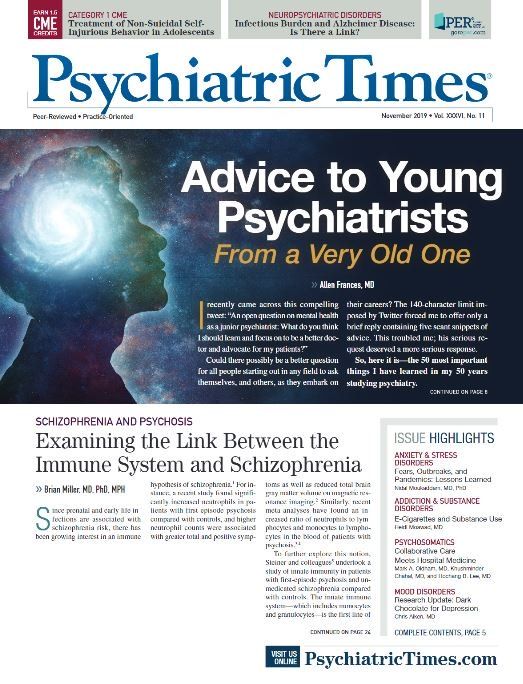Publication
Article
Psychiatric Times
E-Cigarettes and Substance Use
Author(s):
The use of e-cigarettes may precede cigarette smoking as well as the use of other substances, especially among young people.
©alexshalamov/AdobeStock

INTRODUCTION
In 2019, a number of serious health effects and even deaths were reported in association with e-cigarette use. The US government also created new restrictions on e-cigarettes. In addition to the health effects already known about e-cigarettes, adults and young people who obtain them through "black market" routes may experience health effects that have not yet been observed or described, especially if these products contain materials that were not present in products that had been previously legal.
RESEARCH UPDATE
E-cigarettes have become commonplace and are used by people of all ages. Some proponents suggest that they could be safer than traditional cigarettes and that they may be used as a means to prevent or replace the smoking of combustible (regular) cigarettes. Some of the current research shows that use of e-cigarettes is associated with a lower incidence of substance abuse disorder (SUD) and tobacco use disorder (TUD).1
Yet, the use of e-cigarettes may precede cigarette smoking as well as the use of other substances, especially among young people. It is therefore not clear whether e-cigarettes protect against SUD, lead to it, or are a sign of an inherent predisposition to the condition.
The concept of gateway drugs is well established in the area of illegal recreational drugs of abuse. An inherent disposition to SUD could precede or be exacerbated by the use of drugs that are typically considered gateway drugs, such as combustible cigarettes, alcohol, and marijuana. E-cigarettes are also gaining recognition as a potential gateway to smoking cigarettes and using other drugs.
Nicotine and e-cigarettes
E-cigarettes vary in their nicotine content. Not only does the experience of smoking nicotine e-cigarettes differ from the experience of smoking non-nicotine e-cigarettes, the subsequent tendency to smoke regular cigarettes may differ depending on whether a person smokes nicotine e-cigarettes or non-nicotine e-cigarettes.
A recent longitudinal study followed a group of 3474 students beginning when they were 15 and 16 years old, and again when the same students were ages 17 and 18. Students who had smoked nicotine e-cigarettes when they were 15 and 16 years old were more likely to smoke regular cigarettes at age 17 and 18 than the students who had smoked non-nicotine e-cigarettes.2 The researchers found that students who smoked non-nicotine e-cigarettes at aged 15 and 16 years were no more likely to smoke regular cigarettes than students who did not smoke e-cigarettes at all when they were ages 15 and 16.
The researchers concluded that nicotine addiction started with the early use of nicotine e-cigarettes and could have predisposed the students to cigarette addiction as well. There are several other possible reasons for the outcome, however. For example, it is possible that students who smoked non-nicotine e-cigarettes deliberately chose that type of e-cigarette to avoid nicotine exposure or that they did not enjoy nicotine.
E-cigarettes and marijuana
While conclusions remain uncertain, marijuana is often thought of as a gateway drug because its use frequently precedes use of illegal drugs. Among some people, smoking E-cigarettes may predispose marijuana use.
Chadi and colleagues3 examined the relationship between e-cigarettes and subsequent use of marijuana. The researchers found that “odds of marijuana use were higher in youth who had an e-cigarette use history in comparison to those who did not.” They did not distinguish between study participants who used nicotine e-cigarettes and study participants who used non-nicotine e-cigarettes. Given that the study was a large retrospective meta-analysis that included 128,227 participants, it is not easy to draw a conclusion regarding the cause of this link or whether the students were addicted to either substance.
Marijuana is one of the substances commonly used by individuals who suffer from SUD. The role of e-cigarettes prior to the use of marijuana could be related to an inherent tendency to use substances, or it could increase the chances of trying marijuana.
Multi-substance abuse
E-cigarette use is also associated with the use of several substances that are commonly abused among people who suffer from SUD. In a longitudinal multi-center study, Temple and colleagues4 surveyed the drug use habits of 662 participants in an ethnically diverse sample to examine a possible association between e-cigarettes and abuse of other substances.
The researchers found that e-cigarette use was closely linked with use of “combustible cigarettes, alcohol, marijuana, cocaine, amphetamines, inhalants, hallucinogens, ecstasy, and misuse of over-the-counter and prescription medications.” They also noted that users of e-cigarettes reported that their taste was their primary appealing feature. This suggests a very different motive for using e-cigarettes than the motives that are typically associated with some of the other drugs-most of which are not typically associated with a taste. Alcohol, marijuana, and regular combustible cigarettes, all of which have been described as gateway drugs, are, however associated with a distinctive taste, which may also be an appealing factor for some users.
The bottom line
The link between e-cigarettes and numerous drugs that are commonly abused in people who have SUD suggests that e-cigarettes have a stronger effect on users than satisfying their need for the taste, and that they could predispose to use of other drugs.
Take home points
• E-cigarettes are often the first substance that young people use, and they have been associated with a future risk of multi-substance use.
• Adults or youth who are trying to curb their use of regular combustible cigarettes may begin to use e-cigarettes as a strategy to help reduce smoking.
• Adults and youth who use e-cigarettes along with combustible cigarettes are at a higher risk of SUD than those who use e-cigarettes but do not smoke combustible cigarettes.1
• It is worthwhile to discuss warning signs of addiction with patients who use e-cigarettes. At an early stage, patients may be receptive to recognizing, admitting, and addressing the signs of substance abuse disorder before the condition begins.
Dr Moawad is Adjunct Professor at John Carroll University, and Instructor, Case Western Reserve University in Cleveland, OH. She is the Editor in Chief Emeritus of Neurology Times (2017-2019).







